Earth As Art
Mount Saint Helens, Washington, USA
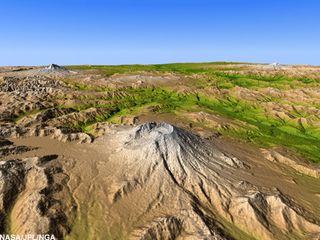
Mount Saint Helens is a prime example of how Earth's topographic form can greatly change even within our lifetimes. The mountain is one of several prominent volcanoes of the Cascade Range that stretches from British Columbia, Canada, southward through Washington, Oregon, and into northern California. Mount Adams (left background) and Mount Hood (right background) are also seen in this view, which was created entirely from elevation data produced by the Shuttle Radar Topography Mission.
Tarpum Bay, Bahamas

In this ASTER image, taken on May 12, 2002, the features that look like folded material are carbonate sand dunes in the shallow waters of Tarpum Bay, southwest of Eleuthera Island in the Bahamas. The sand making up the dunes comes from the erosion of limestone coral reefs, and has been shaped into dunes by ocean currents.
The Shoemaker Impact Structure, Australia
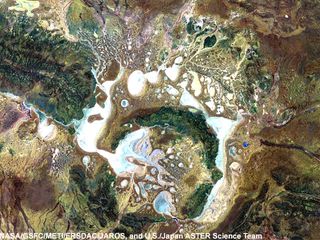
The Shoemaker Impact Structure, Australia, was previously referred to as Teague Ring; it is now named in honor of the late Eugene Shoemaker, a renowned earth and planetary geologist affiliated with Caltech and the US Geological Survey. The precise age of the impact is unknown, but it is estimated between 1000 and 600 million years ago. The structure is 30 km in diameter, and is most easily recognized by the deformation of the resistant ironstones of the Frere Formation, shown in dark green on the image. Low lying areas are salt-encrusted seasonal and dry lakes. This band 3-2-1 ASTER composite was acquired November 4, 2000, covers an area of 44.2 x 45.5 km, and is centered near 25.9 degrees South, 120.9 degrees East.
Australia`s Great Barrier Reef
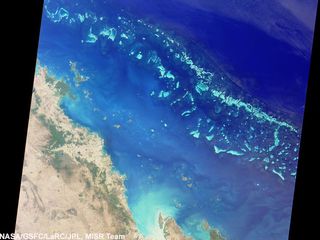
The Great Barrier Reef extends for 2,000 kilometers along the northeastern coast of Australia. It is not a single reef, but a vast maze of reefs, passages, and coral cays (islands that are part of the reef). This nadir true-color image was acquired by the MISR instrument on August 26, 2000 (Terra orbit 3679), and shows part of the southern portion of the reef adjacent to the central Queensland coast. The width of the MISR swath is approximately 380 kilometers, with the reef clearly visible up to approximately 200 kilometers from the coast. It may be difficult to see the myriad details in the browse image, but if you retrieve the higher resolution version, a zoomed display reveals the spectacular structure of the many reefs.
Natural Color Mosaic of United States
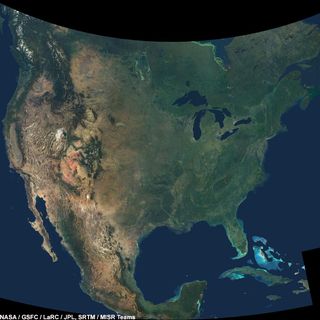
This natural-color image combines cloud-free data from over 500 Multi-angle Imaging SpectroRadiometer (MISR) orbits with shaded relief Digital Terrain Elevation models from the Shuttle Radar Topography Mission (SRTM) and other sources. An astonishing diversity of geological features, ecological systems and human landscapes across North America is indicated within the image, which spans from 56N, 136W at the upper left to 16N 48W at lower right.
Great Wall of China
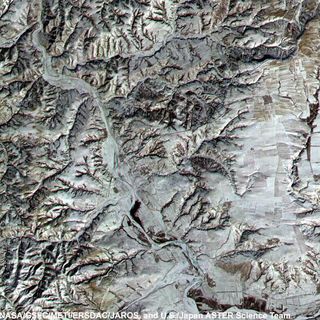
This ASTER sub-image covers a 12 x 12 km area in northern Shanxi Province, China, and was acquired January 9, 2001. The low sun angle, and light snow cover highlight a section of the Great Wall, visible as a black line running diagonally through the image from lower left to upper right. The Great Wall is over 2000 years old and was built over a period of 1000 years. Stretching 4500 miles from Korea to the Gobi Desert it was first built to protect China from marauders from the north.
Malaspina Glacier, Alaska,
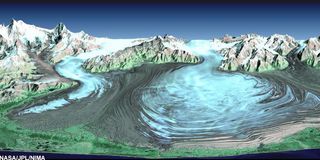
Malaspina Glacier in southeastern Alaska is considered the classic example of a piedmont glacier. Piedmont glaciers occur where valley glaciers exit a mountain range onto broad lowlands, are no longer laterally confined, and spread to become wide lobes. Malaspina Glacier is actually a compound glacier, formed by the merger of several valley glaciers, the most prominent of which seen here are Agassiz Glacier (left) and Seward Glacier (right). In total, Malaspina Glacier is up to 65 kilometers (40 miles) wide and extends up to 45 kilometers (28 miles) from the mountain front nearly to the sea. This perspective view was created from a Landsat satellite image and an elevation model generated by the Shuttle Radar Topography Mission (SRTM).
Sign up for the Live Science daily newsletter now
Get the world’s most fascinating discoveries delivered straight to your inbox.
Athens, Greece

Home of the 2004 Summer Olympic Games. Athens, in southeastern Greece, is the capital and largest city in the country. Situated on the Attic plain, it is surrounded by mountains on three sides, and is served by the port of Piraeus 8 km to the southwest. The Acropolis of Athens has been inhabited since Neolithic times. In the 9th century BC, it was incorporated into the city-state of Athens. Athens reached its golden age in the 5th century BC under Pericles, with a population of perhaps 200,000. This perspective view was made from an image acquired April 29, 2004, draped over a digital elevation model (DEM) created from the same Advanced Spaceborne Thermal Emission and Reflection Radiometer (ASTER) scene.
Alluvial Fan, China
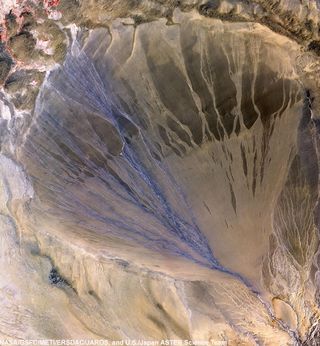
A vast alluvial fan blossoms across the desolate landscape between the Kunlun and Altun mountain ranges that form the southern border of the Taklimakan Desert in China’s XinJiang Province. The left side is the active part of the fan, and appears blue from water currently flowing in the many small streams. The image was acquired May 2, 2002, covers an area of 56.6 x 61.3 km, and is centered near 37.4 degrees north, 84.3 degrees east.
Niagara Falls

The Niagara River (a Native American word for “at the neck”), linking Lake Erie and Lake Ontario, flows around Niagara Island, and then plummets over Horseshoe and American Falls, better known as Niagara Falls. The port city of Buffalo, New York is located at the northeast corner of Lake Erie where the river first leaves the lake. The image also includes the infamous Love Canal. In the late 1970s and early 1980s, as a result of chemical wastes having been dumped in the area of the Love Canal from 1947 to 1952, the area was evacuated. In 1990, after a 12-year cleanup effort, the federal government declared parts of the area habitable and reopened those areas. This image was acquired on September 8, 2001 and covers an area of 56.4 x 53.4 km.
Richat Stucture, Mauritania
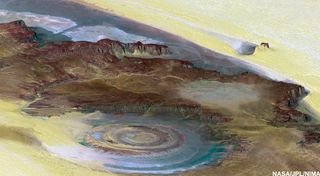
Astronauts often note this prominent circular feature, known as the Richat Structure, in the Sahara desert of Mauritania because it forms a conspicuous 50-kilometer-wide (30-mile-wide) bull's-eye on the otherwise rather featureless expanse of the desert. Initially mistaken for a possible impact crater, it is now known to be an eroded circular anticline (structural dome) of layered sedimentary rocks. Extensive sand dunes occur in this region and the interaction of bedrock topography, wind, and moving sand is evident in this scene. Note especially how the dune field ends abruptly short of the cliffs at the far right as wind from the northeast (lower right) apparently funnels around the cliff point, sweeping clean areas near the base of the cliff. Note also the small isolated peak within the dune field. That peak captures some sand on its windward side, but mostly deflects the wind and sand around its sides, creating a sand-barren streak that continues far downwind.
